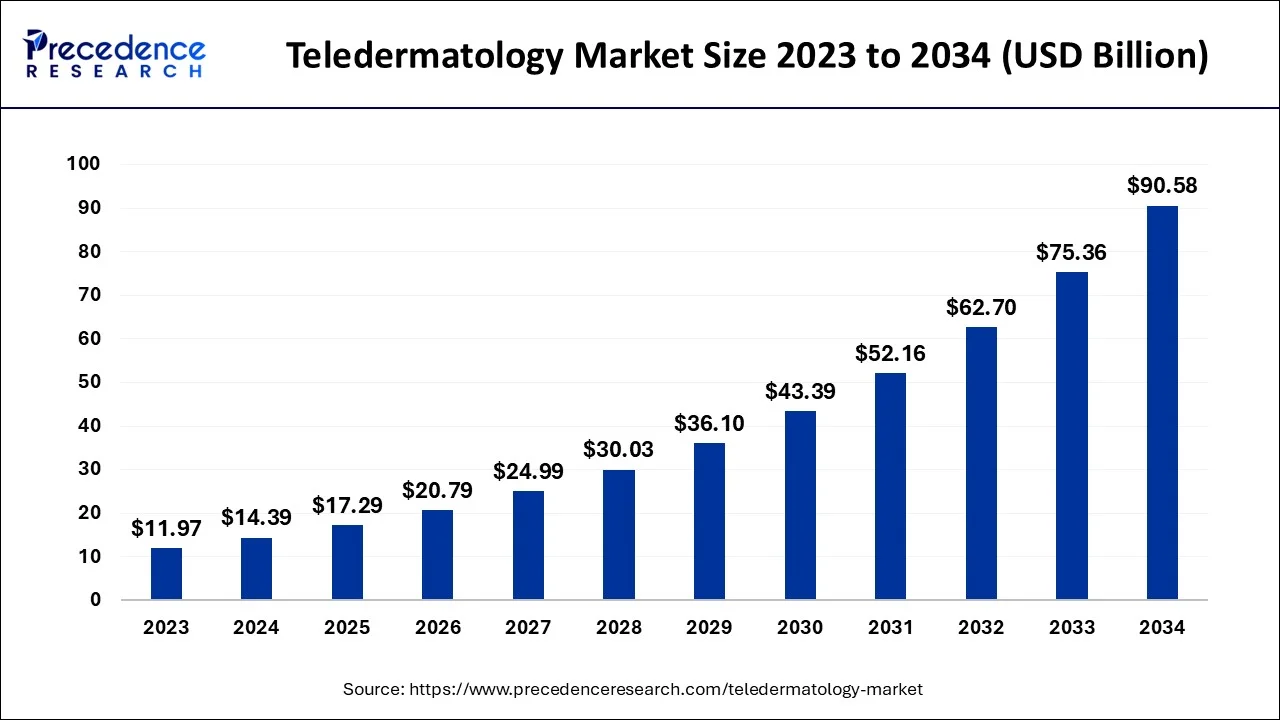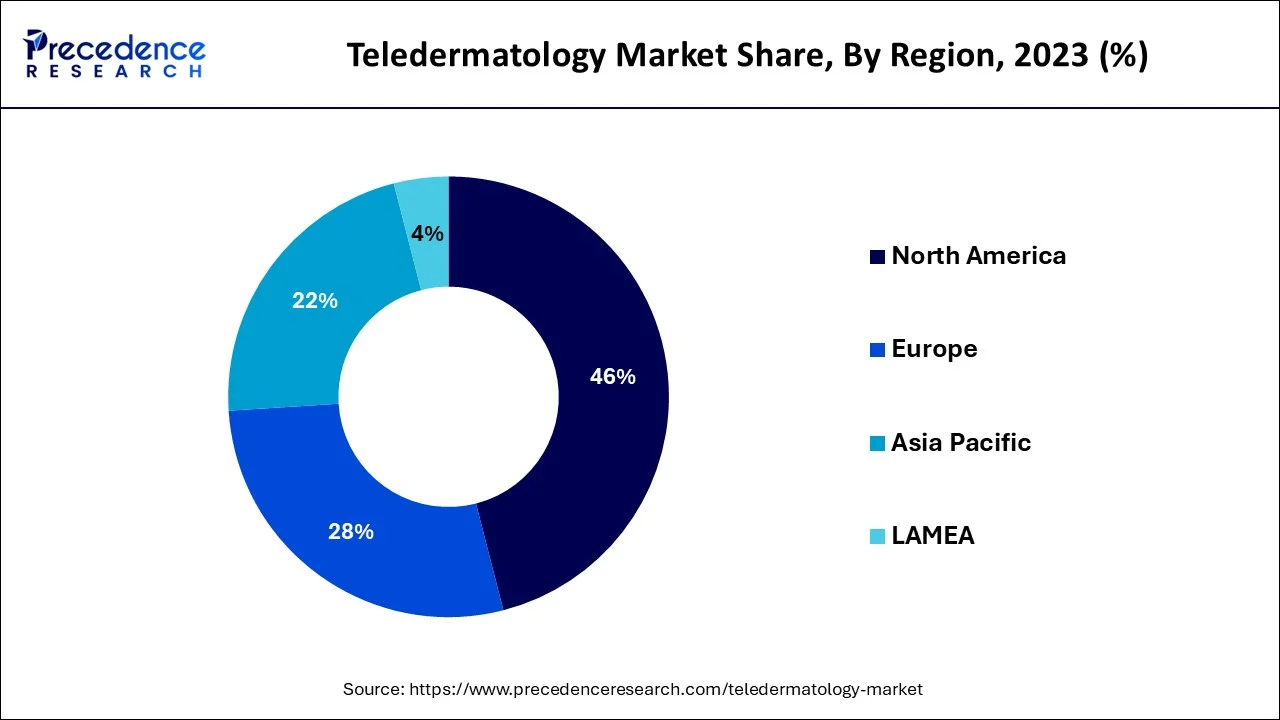The global teledermatology market size accounted for USD 14.39 billion in 2024, grew to USD 17.29 billion in 2025 and is projected to surpass around USD 90.58 billion by 2034, representing a healthy CAGR of 20.20% between 2024 and 2034.
The global teledermatology market size is estimated at USD 14.39 billion in 2024 and is anticipated to reach around USD 90.58 billion by 2034, expanding at a CAGR of 20.20% between 2024 and 2034.

The North America region accounted revenue USD 4.6 billion in 2022. The presence of several top market players such as MDLive and DermatologistsOnCall are fostering the demand for the tele-consultation services. The increased prevalence of various skin diseases in US has augmented the demand for the tele-dermatology. According to the American Academy of Dermatology Association, acne affects around 50 million people annually and it is the most common skin condition. Atopic dermatitis affects around 10% population in US and around 80 million people are affected with hair loss problems. Therefore, the increased prevalence of skin problems coupled with the increased healthcare expenditure and improved access to healthcare facilities has fostered the growth of the tele-dermatology market in North America.

Asia Pacific is estimated to be the most opportunistic market during the forecast period. The rising government initiatives to enhance the healthcare sector and the rising adoption of telehealth and telemedicine are the major factors that drive the growth of the tele-dermatology market in Asia Pacific. Moreover, the rising penetration of internet and the favorable government policies regarding telehealth and reimbursements is expected to drive the growth of the market.
The global teledermatology market gained a rapid momentum in 2023 owing to the outbreak of COVID-19 pandemic. The growing demand for the convenient healthcare services and products among the global consumers is boosting the growth of the global teledermatology market. The rising adoption of the telehealth platforms among the global consumers has positively impacted the growth of the tele-dermatology market. Moreover, the growing prevalence of skin diseases and skin related problems is significantly fueling the demand for the tele-dermatology across the globe. As per the Global Burden of Skin Disease project, the skin disease is the fourth largest cause of non-fatal disease around the globe. Further, it is estimated that around 30% to 70% of the global population is suffering from various skin diseases. Thus, the growing burden of various skin diseases coupled with the rising adoption of the digital health platforms are the major factors behind the growth of the global market.
The rising number of smartphone users and growing penetration of internet across the globe is another important factor that boosts the adoption of the tele-dermatology platforms. According to the International Telecommunication Union, around 4 billion people have access to the internet and majority of them uses smartphones for using the internet. Furthermore, the rising penetration of the social media has boosted the investments by the top market players in the digital marketing and social media marketing to build large customer base. The increasing adoption of the telehealth among the consumers has boosted the availability of the dermatologists and the consultants on the teledermatology platforms. The proliferation of the digital technologies and the integration of the latest technologies like AI and data analytics are fueling the demand for the teledermatology platforms across the globe. Moreover, the development of favorable regulatory framework by the government in various countries regarding the use of telehealth platforms is expected to significantly drive the growth of the tele-dermatology market during the forecast period.
| Report Coverage | Details |
| Market Size In 2024 | USD 14.39 Billion |
| Market Size by 2034 | USD 90.58 Billion |
| Growth Rate from 2024 to 2034 | CAGR of 20.20% |
| Largest Market | North America |
| Fastest Growing Market | Asia Pacific |
| Base Year | 2023 |
| Forecast Period | 2024 to 2034 |
| Segments Covered | Type, Modality, End Use, Region |
| Regions Covered | North America, Europe, Asia-Pacific, Latin America and Middle East & Africa |
Based on the type, the services segment was the dominating segment in 2023 and is expected to be the fastest-growing segment during the forecast period. The teledermatology platforms reduce the wait time for various services of the dermatologists like consultations, monitoring, and education services. The lack of adequate number of dermatologists across the globe has fostered the adoption of the teledermatology, which significantly reduces wait time for the patients to receive the services. The conveniences associated with the virtual services have fostered the growth of the services segment in 2020. The growing awareness regarding the teledermatology platforms among the global consumers is expected to drive the growth of the segment during the forecast period.
The store-and-forward segment has garnering a market share of around 70% in 2023. This is attributed to the increased importance of the store-and-forward for capturing skin images properly. The images of skin become necessary in order to acquire accurate diagnosis and treatment.
The video conferencing segment is expected to grow at a moderate rate during the forecast period. The rising prevalence of acne, hair loss, and other skin related problems, the video conferencing with the dermatologists is preferred, which fuels the growth of this segment.
The healthcare units segment dominated the market with largest revenue share in 2023. The increased adoption of the teledermatology platforms in the hospitals and clinics has fueled the growth of the segment. The increased government investments in the adoption of digital technologies in the hospitals have augmented the demand for the teledermatology platforms in the hospitals.
The homecare segment is estimated to be the most opportunistic segment during the forecast period. The rising disposable income, increased healthcare expenditure, and growing geriatric population are the major factors that are expected to drive the growth of the homecare segment in the forthcoming years.
Segments Covered in the Report
By Type
By Modality
By End User
By Geography
For inquiries regarding discounts, bulk purchases, or customization requests, please contact us at sales@precedenceresearch.com
No cookie-cutter, only authentic analysis – take the 1st step to become a Precedence Research client